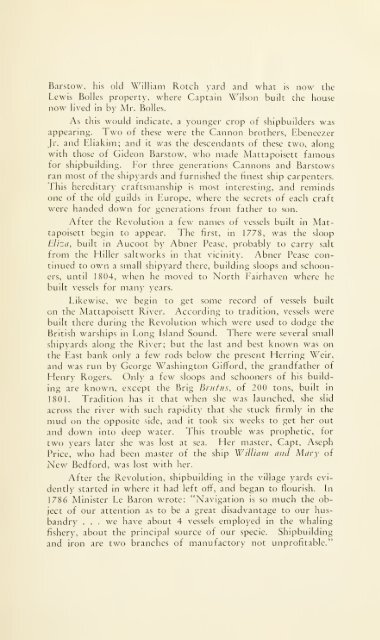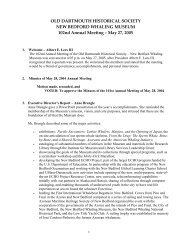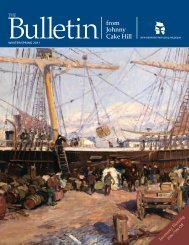shore, drew up to the house still standing there, and pulled outwarrant.a"Bristol, ss. George the I'hird, by the Grace of God, ofGreat Britian, France, and Ireland, King, Defender of the Faith,et cetera —To the Sheriff of our County of Plymouth .Whereas Joseph Rotch and Joseph Nichols both of Sherburnin the County of Nantucket, Merchants, and Joseph Rotch,Jr. of <strong>Dartmouth</strong> in the County of Bristol, Merchant, by theconsideration of our Justices in our Inferior Court of CommonPleas, holden at Taunton .Charles Stetson of Rochester . . . Shipwright,. .. . have recovered judgement againstfor the sum ofthirty-six pounds, six shillings, and sixpense, lawful money of hisMajesty's Province of Massachusetts Bay, we command youtherefore that of the Goods, chattels, or Lands of the said Charlesyou cause to be paid and satisfied to the said Joseph Rotch,. . .Joseph Nichols, and Joseph Rotch, Jr., and for want of Goods,Chattels, or Lands, we command you to take the body of thesaid Charles Stetson and him commit into our Goal at PlymouthAnd so the man who had first brought to the shores ofMattapoisett harbor the sawpit, the scaffolding, the ox-drawnloads of timber, and the ever sounding hammers of the caulkers,went by the board and lost his shipyard. He continued to livein Mattapoisett, as did his sons, for they fought in the Revolutionas Rochester soldiers; but when the war was over, the sons,and perhaps the old father, moved to <strong>New</strong> <strong>Bedford</strong> and establisheda shipyard quite a way north of the present bridge, wherethe Stetson sons built over SO ships for the young village of <strong>New</strong><strong>Bedford</strong>; and the descendants of these men were <strong>New</strong> <strong>Bedford</strong>whaling captains for many years.But Charles Stetson was not the only one. Every shipbuilderwho came to Mattapoisett before the Revolution failed —save one. Gidecn Barstow, who bought his first shipyard propertyfrom William Rotch in 1760, was as prosperous as hiscompetitors were unfortunate, for he not only weathered theRevolution, but by 1784 he and his sons owned every shipyardbut one along this waterfront.In that year his son, Gideon Jr. purchased the R. L. Barstowproperty and continued building there for half a century; andeight years later, Gideon Sr. sold to another son, Captain Wilson
Barstow, his old William Rotch yard and what is now theLewis Bolles property, where Captain Wilson built the housenow lived in by Mr. Bolles.As this would indicate, a younger crop of shipbuilders wasappearing. Two of these were the Cannon brothers, EbeneezerJr. and Eliakim; and it was the descendants of these two, alongwith those of Gideon Barstow, who made Mattapoisett famousfor shipbuilding. For three generations Cannons and Barstowsran most of the shipyards and furnished the finest ship carpenters.This hereditary craftsmanship is most interesting, and remindsone of the old guilds in Europe, where the secrets of each craftwere handed down for generations from father to son.After the Revolution a few names of vessels built in Mattapoisettbegin to appear. The first, in 1778, was the sloopEliza, built in Aucoot by Abncr Pease, probably to carry saltfrom the Hiller saltworks in that vicinity. Abner Pease continuedto own a small shipyard there, building sloops and schooners,until 1 804, when he moved to North Fairhaven where hebuilt vessels for many years.Likewise, we begin to get some record of vessels builton the Mattapoisett River. According to tradition, vessels werebuiltthere during the Revolution which were used to dodge theBritish warships in Long Island Sound. There were several smallshipyards along the River; but the last and best known was onthe East bank only a few rods below the present Flerring Weir,and was run by George Washington Gifford, the grandfather ofHenry Rogers. Only a few sloops and schooners of his buildingare known, except the Brig Brutus, of 200 tons, built in1801. Tradition has it that when she was launched, she slidacross the river with such rapidity that she stuck firmly in themud on the opposite side, and it took six weeks to get her outand down into deep water. This trouble was prophetic, fortwo years later she was lost at sea. Her master, Capt. AsephPrice, who had been master of the ship Williciiu mid Mary of<strong>New</strong> <strong>Bedford</strong>, was lost with her.After the Revolution, shipbuilding in the village yards evidentlystarted in where it had left off, and began to flourish. In1786 Minister Le Baron wrote: "Navigation is so much the objectof our attention as to be a great disadvantage to our husbandry... we have about 4 vessels employed in the whalingfishery, about the principal source of our specie. Shipbuildingand iron are two branches of manufactory not unprofitable."
- Page 1 and 2: FJ2504-No.G'^
- Page 3: XSHIPBUILDERS OF MATTAPOISETTBy Cha
- Page 6 and 7: Edgartown, Dartmouth, Wcstport, New
- Page 8 and 9: and shoals, and the horrible menace
- Page 10 and 11: established shipyards and wharves,
- Page 14 and 15: Scattered records are being brought
- Page 16 and 17: fleets. From his yard, also, came t
- Page 18 and 19: Down at Cannonville at the foot of
- Page 20 and 21: iver." And in September 1828, the N
- Page 22: uilt by Barstow & Holmes in 1820. T
- Page 25 and 26: "A fine medium clipper ship of abou
- Page 27 and 28: Eliza, Si., 61 T., Abner Pc.isc (Pr
- Page 29 and 30: 1819Barclay, Ship, 301 T., Barstow
- Page 31 and 32: Mariner, Ship, 349 T., G. Barstow &
- Page 33 and 34: 1848Eliza, Sch., 139 T., N. H. liar
- Page 35 and 36: Reminiscences:ThreePUBLICATIONSOFTH
- Page 37: 52. The Arnold Mansion and Its Trad













